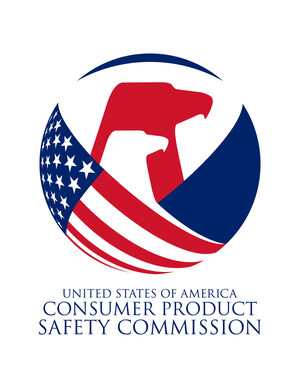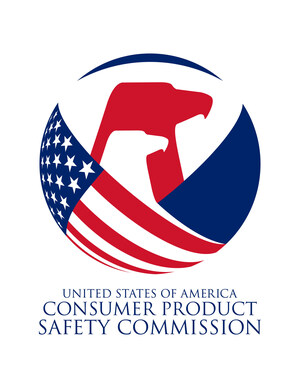WASHINGTON, Feb. 28, 2013 /PRNewswire-USNewswire/ -- Having led the U.S. Consumer Product Safety Commission (CPSC) through one of the most significant transformations in the agency's history, Chairman Inez M. Tenenbaum announced today that she will not seek renomination when her terms expires in October 2013.
(Logo: http://photos.prnewswire.com/prnh/20030904/USCSCLOGO)
In an address at the International Consumer Product Health and Safety Organization annual meeting, the Chairman stated: "I plan to stay on as Chairman until my successor is nominated by the President and confirmed by the Senate, so that I can be sure that the U.S. Consumer Product Safety Commission is in safe hands."
"So many qualified, deserving people have wanted to serve in the President administration—and he chose me. For the rest of my life, I will be grateful to President Obama for nominating me to be Chairman of the CPSC and for giving me the opportunity to serve in his administration," added the Chairman. "It has been my great privilege to serve as Chairman of the CPSC, and the best part of my experience has been working with the many talented, dedicated professionals at the agency. "
Chairman Tenenbaum has transformed CPSC into one of the leading safety agencies in the world. Immediately after her July 2009 swearing in, Chairman Tenenbaum established a leadership philosophy aimed at making the agency more accessible and transparent; making education and advocacy a priority; and being firm, but fair, in enforcing safety laws and working to keep unsafe products out of the hands of consumers. In October 2010, Chairman Tenenbaum announced a new five-year Strategic Plan (2011-2016), which set forth a twenty-first century mission and vision for CPSC. The Strategic Plan has made CPSC more proactive, more focused on injury prevention, and moved the agency closer to being the recognized global leader in consumer product safety.
During the Chairman's tenure to date, CPSC has restored consumer confidence and achieved its mission. Below are the agency's key accomplishments from 2009 through 2012:
Leadership in Product Safety
CPSC is at the forefront of advancing the agenda for consumer product safety, and takes a leadership role in identifying and addressing the most pressing consumer product safety priorities and mobilizing action by our partners. By collaborating with key global and domestic stakeholders, CPSC leverages its limited resources to improve product safety and mitigate the most pressing product safety hazards.
- Led international efforts in collaborating on consumer product safety:
- Participated in bilateral and trilateral safety summits with the People's Republic of China, the European Union, Canada, and Mexico
- Trained 17,000 executive, quality control, and manufacturing professionals throughout Asia
- Established a CPSC office in Beijing
- Led the effort with the Organisation of Economic Cooperation and Development to establish the first global recalls portal.
- In 2010, CPSC created the Office of Education, Global Outreach, and Small Business Ombudsman to coordinate and provide outreach to various domestic and international stakeholders, including manufacturers, retailers, resellers, small businesses, and foreign governments. The office is dedicated to addressing the questions and concerns of the regulated community.
- CPSC created a full-time Small Business Ombudsman position in FY 2011 to serve the nation's many small businesses in the area of product safety.
- Awarded the Chairman's Commendation Circle Award to recognize people and groups who have contributed in an important way to the benefit of consumers by directly and significantly reducing deaths, preventing injuries, and improving consumer product safety. Since the program was established in 2011, there have been nine Chairman's Commendation Circle Award recipients.
Commitment to Prevention
CPSC protects consumers by promoting production of safe consumer products and the development and implementation of safety standards for manufacturers, which focuses on safety early in the supply chain and help prevent hazardous products from entering consumer markets in the first place. CPSC participates in the development of voluntary safety standards, issues mandatory safety rules, trains industry stakeholders on regulatory requirements and hazard identification best practices, and engages foreign product safety regulators and foreign manufacturers to reduce production of unsafe consumer products that could enter the U.S. market. Since passage of the Consumer Product Safety Improvement Act (CPSIA) in 2008, CPSC has focused on implementing significant portions of the Act.
- CPSC completed 40 final rules since the adoption of CPSIA through 2012, including, among others:
- mandatory rules for durable infant or toddler products, including: cribs, infant bath seats, infant walkers, toddler beds, portable bed rails, infant swings, and play yards;
- a rule on Testing and Labeling Pertaining to Product Certification, establishing the requirements for children's product certification and required third party testing;
- a rule on Conditions and Requirements for Relying on Component Part Testing to Meet Certification Requirements, establishing the requirements for testing component parts in support of the certification of a product regulated by the Commission (both children's and non-children's products);
- a rule on Guidelines and Requirements for Mandatory Recall Notices;
- rules designating certain children's upper outerwear and certain hand-supported hair dryers as substantial product hazards under 15(j) of the CPSA; and
- a rule on Requirements for Consumer Registration of Durable Infant or Toddler Products.
- CPSC held the first CPSC Safety Academy in FY 2012 for more than 100 representatives of manufacturers, retailers, distributors, associations, and government organizations to provide training and discussion of CPSC's regulations.
Rigorous Hazard Identification
CPSC analyzes information on injuries, deaths, and other consumer product safety incidents to determine which product hazards represent the greatest risks to consumer safety. Sources include consumers and consumer groups, hospitals and clinics, industry, and the press, as well as economic and hazard exposure information on products under its jurisdiction. CPSC works to improve the quality of crucial product hazard data, and staff investigates specific injury cases to gain additional knowledge about injuries or hazards and any consumer products involved.
- CPSC launched the publicly available Consumer Product Safety Information Database, available at www.SaferProducts.gov, in March 2011. Consumers have the ability to report consumer products that cause harm or pose a risk of harm and to search reports submitted by others in order to make informed decisions about the products they own or are considering purchasing. Since the site launched, 4,217 businesses registered through the business portal, and CPSC posted 13,147 reports of harm on www.SaferProducts.gov.
- In FY 2012, CPSC collected more than 400,000 NEISS reports and more than 10,000 death certificates, medical examiner reports, and coroner reports.
- CPSC has developed a robust import enforcement program, leveraging our partners at U.S. Customs and Border Protection (CBP), and expanded the placement of CPSC experts co-located at some of the largest ports in the country. In 2012, CPSC screened more than 17,000 models of imported consumer products at U.S. ports.
- CPSC staff worked with CBP to develop the pilot Risk Assessment Methodology (RAM), which aligns with the President's National Strategy for Global Supply Chain Security and utilizes improved information technology to target the highest risk imports that are most likely to violate consumer product safety statutes and regulations.
Decisive Response
Once hazardous products have been identified, the CPSC takes action to protect consumers. CPSC intercepts goods at ports before they are distributed in commerce and holds violators accountable. Field staff conducts investigations of incidents and injuries, and inspections of manufacturers, retailers, and importers. Multidisciplinary teams of CPSC staff review investigative reports and product samples to determine when possible violations and defects warrant corrective action. When a recall is necessary, CPSC staff negotiates with the firm to seek a voluntary recall when possible.
- CPSC secured more than $17 million in civil penalties from FY 2010 through February 2013, for violation of mandatory regulations, including the lead paint ban, lead content, and federal fireworks regulations; and for failing to report in a timely manner defects or potential defects in a wide range of consumer products, including children's upper outerwear, exercise equipment, appliances, lawn equipment, furniture, toys, lithium-ion battery packs, baby flotation boats, and others.
- In 2011, CPSC opened the new National Product Testing and Evaluation Center (NPTEC), where CPSC scientists and engineers test potentially hazardous products for defects and develop testing methods to determine compliance with safety standards. NPTEC has enhanced the CPSC's ability to protect families and consumers from harm by expanding testing capabilities and increasing the efficiency of agency staff and equipment.
Raising Awareness
Raising awareness of longstanding, hidden, and emerging product safety hazards is crucial to empowering consumers and reducing the risk of death and injury. CPSC has had success in educating the public and industry through increased use of social media, traditional media, and targeted safety campaigns that aim to reach vulnerable populations affected by, but not necessarily aware of certain product hazards.
- CPSC issued more than 2,000 press releases and recall alerts and disseminated tens of thousands of electronic safety messages through CPSC's website.
- In 2010, CPSC launched the Pool Safely campaign, a first-of-its-kind, multiyear media and education campaign aimed at preventing child drowning incidents and drain entrapments in pools and spas. The Pool Safely campaign has more than 500 partners across the country.
- CPSC has partnered with safety advocacy and community groups and state and local government agencies to implement the Safe Sleep outreach and education effort, which promotes safe sleeping environments for babies and toddlers. It also highlights the new crib safety standards that prohibit the sale of drop-side cribs in the United States and warns of hazards associated with soft bedding, infant slings, sleep positioners, and baby monitor cords.
General Accomplishments
- In August 2011, the Commission announced a reorganization of its management structure to meet its mission challenges in an ever-changing global marketplace. In response to a rapidly expanding marketplace of consumer goods, making the challenge of overseeing and regulating the thousands of product types within the agency's jurisdiction all the more complex, the Commission realigned the organization with agency priorities established in its strategic plan.
- CPSC has undertaken a multiyear IT modernization effort to standardize how data are captured and integrate once-disparate systems to enable analysis and manage caseloads across the agency. As part of this effort, CPSC is developing the Consumer Product Safety Risk Management System (CPSRMS), Dynamic Case Management (DCM) system, and a redesigned website.
- CPSC updated its business processes to better detect emerging hazards and manage incoming incident data. The creation of Integrated Product Teams (IPTs), made up of staff from multiple offices and disciplines throughout the agency, is a collaborative approach to hazard identification. The IPTs are a critical element in facilitating the prioritization and identification of emerging hazards.
Media Contact
Please use the phone numbers below for all media requests.
Scott Wolfson, Director of the Office of Communications
Phone: (301) 504-7051
Chairman Tenenbaum's photo is available at http://www.cpsc.gov/en/About-CPSC/Chairman/Chairmans-Biography/
The U.S. Consumer Product Safety Commission is charged with protecting the public from unreasonable risks of injury or death associated with the use of the thousands of consumer products under the agency's jurisdiction. Deaths, injuries and property damage from consumer product incidents cost the nation more than $900 billion annually. CPSC is committed to protecting consumers and families from products that pose a fire, electrical, chemical or mechanical hazard. CPSC's work to ensure the safety of consumer products - such as toys, cribs, power tools, cigarette lighters and household chemicals – contributed to a decline in the rate of deaths and injuries associated with consumer products over the past 30 years.
Federal law bars any person from selling products subject to a publicly-announced voluntary recall by a manufacturer or a mandatory recall ordered by the Commission.
To report a dangerous product or a product-related injury go online to www.SaferProducts.gov or call CPSC's Hotline at (800) 638-2772 or teletypewriter at (301) 595-7054 for the hearing impaired. Consumers can obtain news release and recall information at www.cpsc.gov, on Twitter @OnSafety or by subscribing to CPSC's free e-mail newsletters.
SOURCE U.S. Consumer Product Safety Commission
WANT YOUR COMPANY'S NEWS FEATURED ON PRNEWSWIRE.COM?
Newsrooms &
Influencers
Digital Media
Outlets
Journalists
Opted In





Share this article